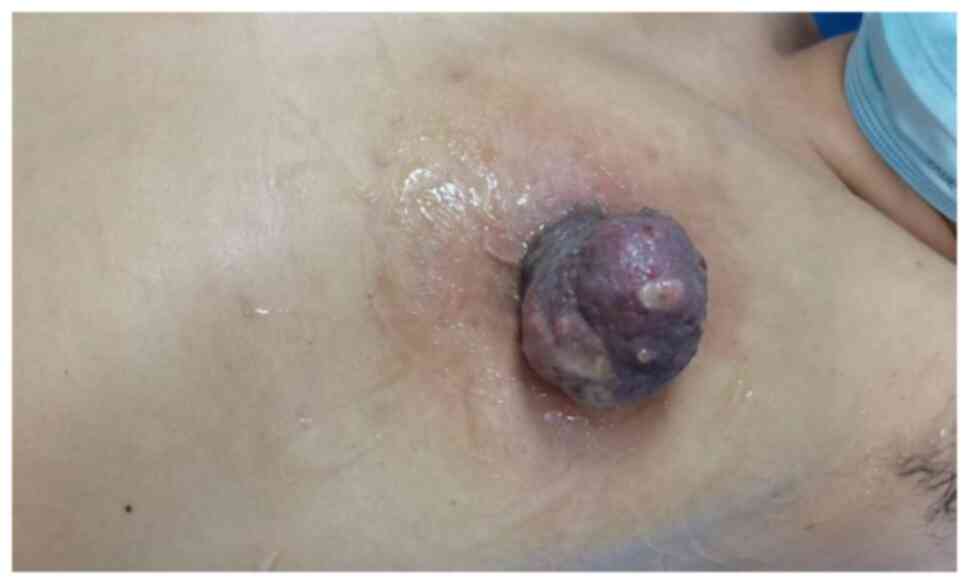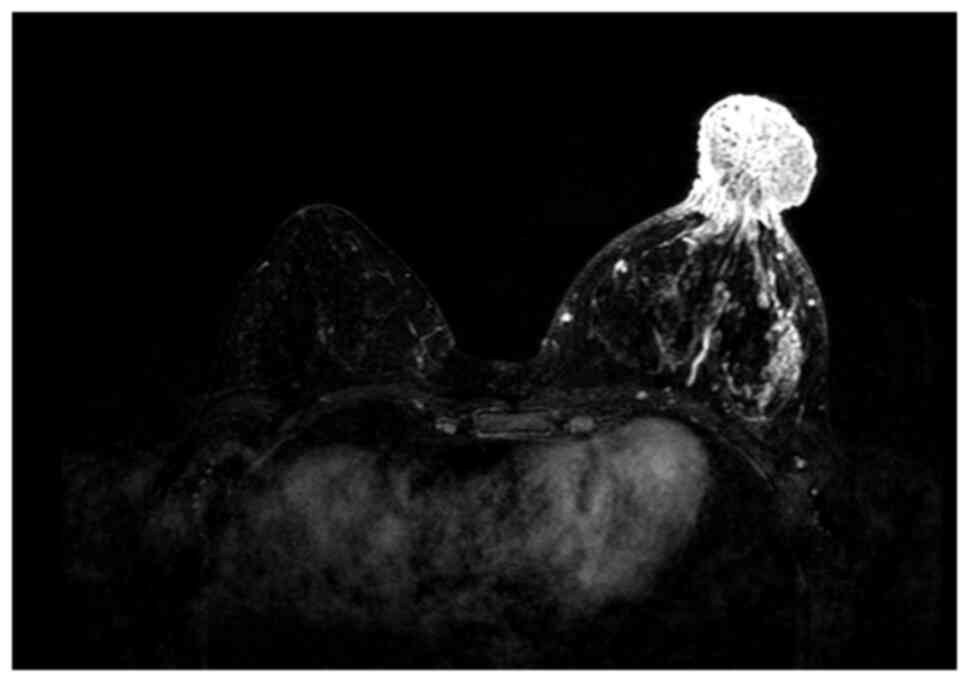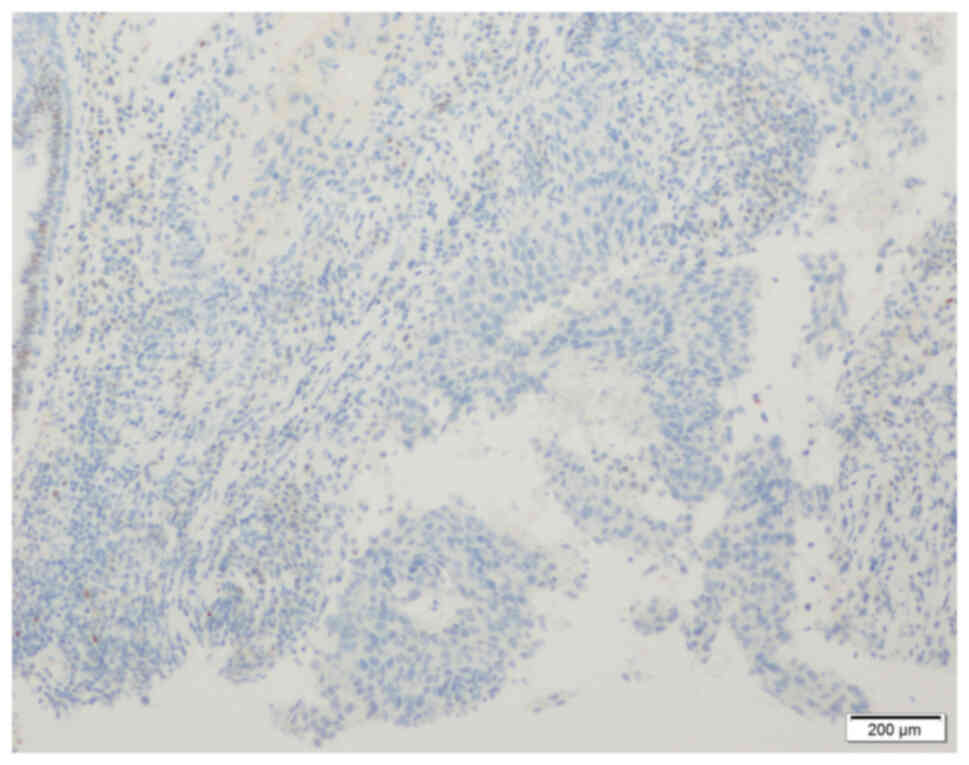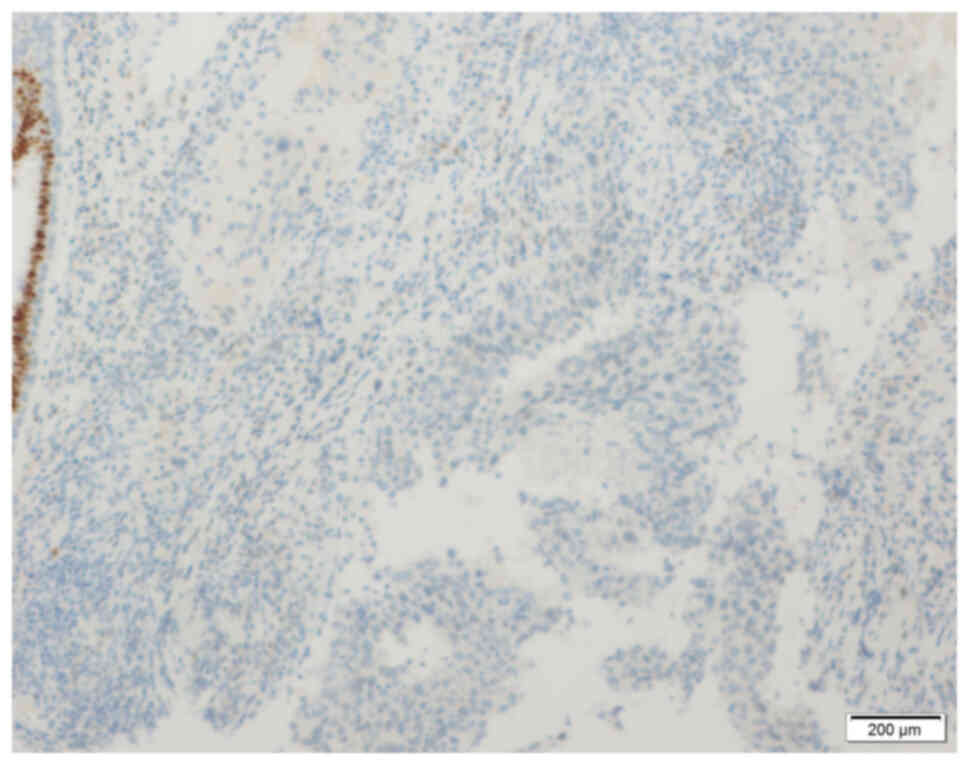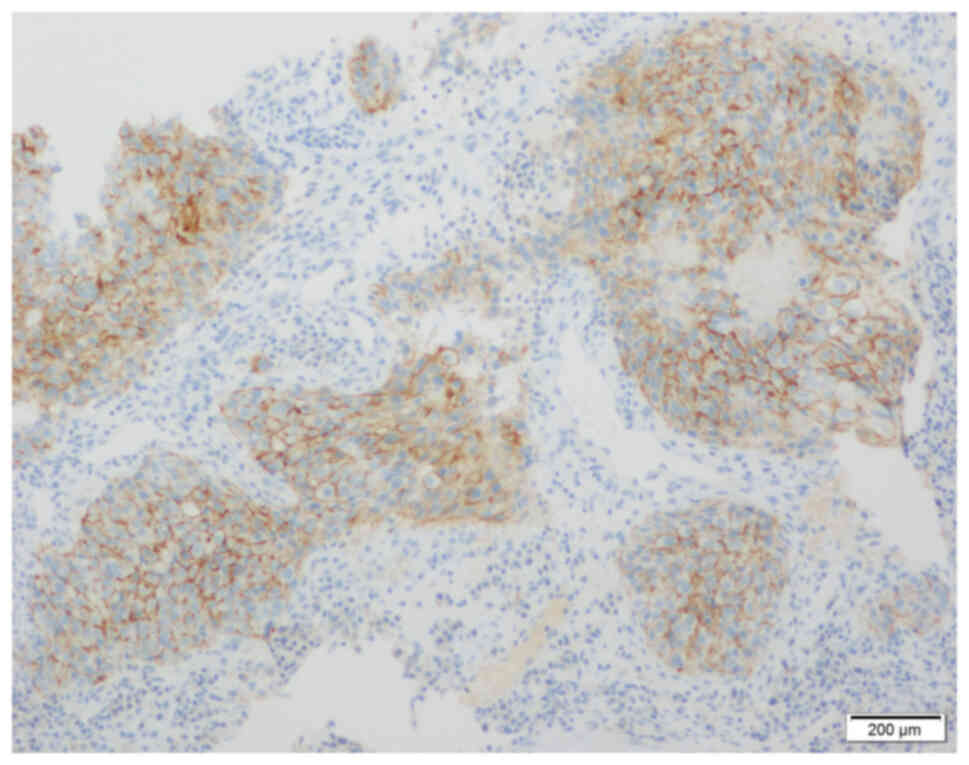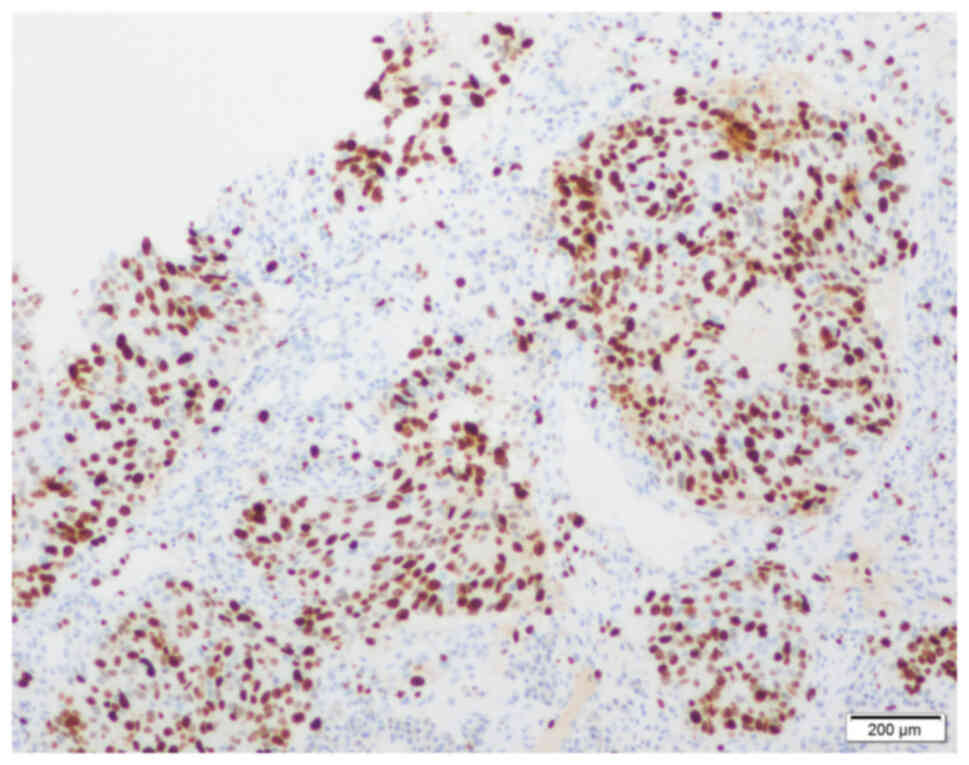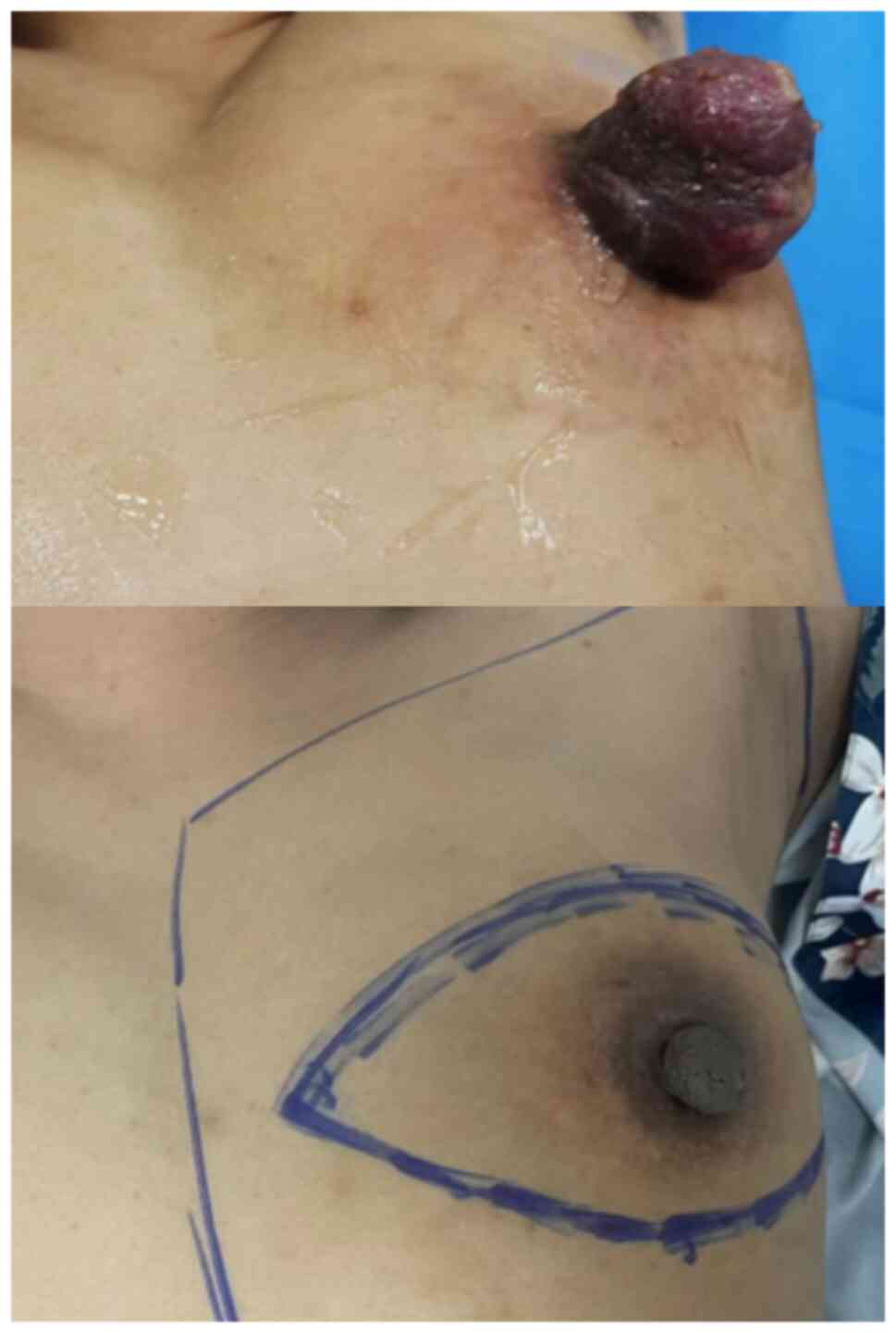Neoadjuvant chemotherapy for primary invasive ductal carcinoma of the nipple: A case report
- Authors:
- Published online on: August 22, 2024 https://doi.org/10.3892/ol.2024.14639
- Article Number: 506
-
Copyright: © Sun et al. This is an open access article distributed under the terms of Creative Commons Attribution License.
Abstract
Introduction
Invasive breast cancer originating in the nipple is very rare, occurring in 0.25% of breast cancers (1). Sanders et al (2) was the first to term this rare condition as nipple-invasive primary carcinoma. Nipple-invasive primary carcinoma has previously been described in two conditions: i) Secondary to Paget's disease, where tumor cells of the epidermis invade directly into the dermis; and ii) invasive carcinoma arising from the internal ducts or lobules of the papilla (2). The present case belonged to the latter. Previous cases have reported that this rare condition may have multiple clinical manifestations (2–11). Only 6 out of 23 (26%) cases presented with a nipple mass, 12 (48%) had pagetoid changes such as eczema, pruritus or erosion, and 6 presented with only an edematous thickened nipple (Table I) (2–11). Imaging examinations occasionally show no significant abnormalities, and only 11 of the 21 cases with imaging findings reported abnormal changes, such as masses or microcalcifications in the nipple (2–11). Atypical clinical manifestations and imaging findings are considered to lead to missed diagnoses despite the absence of definitive statistical studies. Axillary lymph node metastases have been identified in up to 8 (40%) of the previous 20 cases in which axillary surgery was performed, and it can be speculated that this may be associated with delayed diagnosis (2–11). Therefore, the present report aims to increase attention of this condition.
Case report
A 40-year-old female patient was admitted to the Second Hospital of Jilin University (Changchun, China) on 16 August 2022 due to an enlarged firm mass on the left nipple with an ulcerated surface and exudation of clear fluid (Fig. 1). X-ray examination revealed an enlargement and increased density of the left nipple, measuring ~ 3.5×3.2 cm, and MRI demonstrated a mass-like abnormal signal shadow in the left papillary region and axillary lymphadenopathy (Fig. 2).
A total of three months prior, the patient had noticed left nipple enlargement and then underwent pathological biopsy of the nipple skin at The First Hospital of Jilin University (Changchun, China), which showed spongiform dermatitis of the nipple skin with lymphedema. However, the mass continued to enlarge in the following 3 months and showed enlarged axillary lymph nodes, therefore a second pathological biopsy was performed. A core needle biopsy was performed on the nipple mass and axillary lymph nodes, and the results revealed invasive ductal carcinoma of the nipple (World Health Organization classification of breast tumors) and axillary lymph node metastasis (12). The immunohistochemistry (IHC) results were negative for estrogen receptor (ER; Fig. 3), progesterone receptor (PR; Fig. 4) and human epidermal growth factor receptor-2 (HER-2; Fig. 5). Ki-67 index was measured manually as 60% (Fig. 6). IHC staining was performed using paraffin-embedded breast cancer tissue sections of 3 µm thickness soaked in 10% neutral formaldehyde for 6–12 h at room temperature. Antigen retrieval was performed by soaking the sample in sodium citrate buffer (pH 6.0; 0.01 M), heating the water barrier to 92–98°C for 15–20 min, and then cooling at room temperature for 20–30 min followed by rinsing with distilled water and PBS buffer. Permeabilization was performed in 0.1–0.3% TritonX-100 at room temperature for 25 min, and rinsed with PBS three times for 5 min each. Blocking was performed with 2–5% bovine serum albumin at room temperature for 10–30 min. Sections were soaked in 3% hydrogen peroxide for 20 min to block endogenous peroxidase activity. Primary antibodies used for ER, PR, HER2 and Ki-67 were EP1 (Origene Technologies, Inc.; cat. no. ZA-0102; 5 µg/ml), EP2 (Origene Technologies, Inc.; cat. no. ZA-0255; 5 µg/ml), UMAB36 (Origene Technologies, Inc.; cat. no. ZM-0065; 1:50) and UMAB107 (Origene Technologies, Inc.; cat. no. ZM-0166; 1:300), respectively, and incubated with the tissues at 37°C for 32 min. Secondary antibodies were provided by the ultraView Universal DAB Detection Kit (Roche Tissue Diagnostics; cat. no. 760-500) and incubated for 8 min at 37°C. The chromogen detection reagent was DAB. Counterstaining was performed with hematoxylin for 10 sec at room temperature. The OLYMPUS BX51 Fluorescence Microscope (Olympus Corporation) was used for observation. Staging examinations included bilateral supraclavicular ultrasound, liver ultrasound lung CT, and whole-body bone scintigraphy, which revealed no distant metastasis (The American Joint Committee on Cancer) (13).
Considering the locally advanced disease, the patient was administered 6 cycles of neoadjuvant chemotherapy with nab-paclitaxel [intravenously guttae (i.v.gtt); 260 mg/m2], epirubicin (i.v.gtt; 75 mg/m2) and cyclophosphamide (i.v.gtt; 500 mg/m2) -, and each cycle was 21 days (Fig. 7). The first administration of chemotherapy was performed in August 2022. Subsequently, the patient underwent a modified radical mastectomy in December 2022 and achieved a pathological complete response (pCR), which included the axillary lymph nodes. A total of 25 cycles of adjuvant radiotherapy was administered postoperatively. The patient was last reviewed in April 2024 and showed no signs of recurrence or metastasis.
Discussion
Table I presents the previously reported cases of nipple-invasive primary carcinoma (not secondary to Paget's disease). Previous cases have reported that this invasive carcinoma arising in the nipple has several manifestations, such as nipple mass, eczematous changes, edematous thickened nipples or nipple bleeding (2–11). Notably, eczematoid lesions do not equate to epidermal invasion, and there are certain cases in which Paget's disease-like changes are present but there are no Paget's cells present in the epidermis; therefore, Paget's disease is excluded (2,4–9). Imaging studies can sometimes detect abnormal changes, such as masses or microcalcifications in the nipple, but there are also cases in which eczematous changes in the nipple are only present, whilst imaging studies do not show any abnormalities, suggesting that a pathological biopsy can actively be performed (2,4,6–8).
Core needle biopsy can be performed for nipple masses and suspicious lymph nodes, whilst open freehand biopsy can be performed for eczematous changes. Notably, certain cases have no epidermal infiltration, so epidermal scraping alone may lead to a missed diagnosis 4. The patient in the present case presented to another healthcare facility with nipple enlargement 3 months prior to diagnosis. Punch biopsy of the nipple skin and core needle biopsy of the axillary lymph nodes revealed spongiform dermatitis of the nipple skin with dermal lymphedema, and no carcinomatous infiltration of the axillary lymph nodes. This could have been due to small lesions or inadequate biopsy sampling at that time.
Core needle biopsy pathology confirmed the present case as triple-negative breast cancer (TNBC), that is, lack of expression of ER, PR, and HER-2; however, most previous reported cases were hormone receptor-positive (95%) (2,3,6,7,9,11). Compared with other molecular subtypes, TNBC has a more unfavorable prognosis, but is more sensitive to chemotherapy, and pCR is more likely to be achieved after neoadjuvant chemotherapy (14). According to the National Comprehensive Cancer Network guidelines for breast cancer, neoadjuvant chemotherapy is recommended for TNBC that is >2 cm in diameter or TNBC with positive lymph nodes (15). In the present case, Ki-67 proliferation index was relatively high at 60%. Ki-67 index is used as an indicator of proliferative activity and also as a predictor of response to treatment (16). Many previous studies have reported that patients with TNBC with high Ki-67 protein levels are more likely to achieve pCR after receiving neoadjuvant chemotherapy (17). Pathologic response to neoadjuvant chemotherapy is associated with long-term prognosis, with prolonged survival in patients achieving pCR than in those with residual tumor, and this association has been reported to be strongest in TNBC (14).
To the best of our knowledge, the present case is the first case of neoadjuvant chemotherapy for invasive breast cancer originating in the nipple. Following the Chinese Society of Clinical Oncology guidelines for breast cancer, the present case administered a TEC regimen and the patient achieved pCR (including axillary lymph nodes) after 6 cycles of chemotherapy (18). Other regimens have also demonstrated efficacy in neoadjuvant chemotherapy for TNBC, but anthracycline- and taxane-based regimens remain the first choice (19). Furthermore, a retrospective study by Liedtke et al (14) reported that anthracycline combined with taxane had the highest pCR rate compared with anthracycline alone, taxane alone, or other regimens. It was concluded that anthracycline + taxane was the most effective regimen for TNBC.
In the choice of the surgical approach, total mastectomy is performed in most cases, and the surgical principles of the axilla are identical to those of invasive breast cancer (4,5,10,11). However, Moliere et al (3) performed central breast-conserving surgery with negative margins followed by postoperative radiotherapy in the absence of other suspicious lesions on MRI, suggesting that, although nipple breast cancer may occur with other breast lesions, central breast-conserving surgery is also an option under the premise of adequate imaging assessment.
To summarize, the present paper reports a rare case of primary invasive carcinoma of the nipple. For abnormal changes in the nipple, clinicians should be aware of the possibility of breast cancer in the nipple and timely select the appropriate way for pathological biopsy to avoid delay in diagnosis and treatment. The present case also suggests that for primary breast cancer of the nipple suitable for neoadjuvant therapy, the choice of treatment can also refer to common breast cancer.
Acknowledgements
Not applicable.
Funding
Funding was received from the Natural Science Foundation of Jilin Province of China (grant no. YDZJ202401165ZYTS).
Availability of data and materials
The data generated in the present study may be requested from the corresponding author.
Authors' contributions
KS proposed the main conceptual ideas, developed the structure, wrote and edited the manuscript. MZ obtained medical images, collected data, assisted with the preparation of tables and figures and polished the language. GC performed biopsy procedures, managed the patient during diagnosis and treatment, revised the manuscript and provided guidance and supervision throughout the writing process. BL made treatment decisions, advised on neoadjuvant chemotherapy, performed surgical treatment and provide financial support for this project. All authors have read and approved the final manuscript. KS and BL confirm the authenticity of all the raw data.
Ethics approval and consent to participate
Not applicable.
Patient consent for publication
The verbal informed consent was obtained from the patient for the publication of their anonymous information in the present article. Written informed consent was not obtained due to the personal circumstances of the patient.
Competing interests
The authors declare that they have no competing interests.
References
|
Congdon GH and Dockerty MB: Malignant lesions of the nipple exclusive of Paget's disease. Surg Gynecol Obstet. 103:185–192. 1956.PubMed/NCBI | |
|
Sanders MA, Brock JE, Harrison BT, Wieczorek TJ, Hong X, Guidi AJ, Dillon DA, Max L and Lester SC: Nipple invasive primary carcinomas: Clinical, imaging, and pathologic features of breast carcinomas originating in the nipple. Arch Pathol Lab Med. 142:598–605. 2018. View Article : Google Scholar : PubMed/NCBI | |
|
Moliere S, Lodi M, Roedlich MN and Mathelin C: Invasive ductal carcinoma limited to the nipple. Breast J. 24:10832018. View Article : Google Scholar : PubMed/NCBI | |
|
Kasuga Y, Oohashi T, Nagai N, Tsuchiya S and Sugenoya A: Primary scirrhous carcinoma of the nipple with symptoms simulating Paget's disease: Report of a case. Surg Today. 23:356–359. 1993. View Article : Google Scholar : PubMed/NCBI | |
|
Ohsumi S, Nozaki II, Takashima S and Mandai K: Invasive ductal carcinoma of the nipple: A case report. Breast Cancer. 3:215–218. 1996. View Article : Google Scholar : PubMed/NCBI | |
|
Ahmed M and Basit A: Isolated adenocarcinoma of the nipple. BMJ Case Rep. 2011:bcr02201138252011. View Article : Google Scholar : PubMed/NCBI | |
|
Erben Y, Ghosh K, Nassar A, Gimenez E and Jakub JW: Invasive lobular carcinoma of the nipple. Breast J. 18:280–281. 2012. View Article : Google Scholar : PubMed/NCBI | |
|
Moennich J, Ort R, High W and Brown M: Breast carcinoma masquerading as basal cell carcinoma of the nipple. JAAD Case Rep. 1:361–363. 2015. View Article : Google Scholar : PubMed/NCBI | |
|
Pasquali P, Freites-Martinez A, Camacho E and Fortuno A: A painful nipple: A rare presentation for an infiltrating lobular carcinoma. Breast J. 22:117–118. 2016. View Article : Google Scholar : PubMed/NCBI | |
|
Tan QT and Mihir AG: A case of invasive ductal carcinoma presenting as an exophytic nipple mass. Breast J. 25:1000–1001. 2019. View Article : Google Scholar : PubMed/NCBI | |
|
Hamzah JL, Ong KW and Tan BY: Isolated invasive ductal carcinoma of the nipple-areolar complex: A rare occurrence yet to be reported in current literature. Breast J. 25:706–708. 2019. View Article : Google Scholar : PubMed/NCBI | |
|
Tan PH, Ellis I, Allison K, Brogi E, Fox SB, Lakhani S, Lazar AJ, Morris EA, Sahin A, Salgado R, et al: The 2019 world health organization classification of tumours of the breast. Histopathology. 77:181–185. 2020. View Article : Google Scholar : PubMed/NCBI | |
|
Kalli S, Semine A, Cohen S, Naber SP, Makim SS and Bahl M: American joint committee on cancer's staging system for breast cancer, eighth edition: What the radiologist needs to know. Radiographics. 38:1921–1933. 2018. View Article : Google Scholar : PubMed/NCBI | |
|
Liedtke C, Mazouni C, Hess KR, Andre F, Tordai A, Mejia JA, Symmans WF, Gonzalez-Angulo AM, Hennessy B, Green M, et al: Response to neoadjuvant therapy and long-term survival in patients with triple-negative breast cancer. J Clin Oncol. 41:1809–1815. 2023. View Article : Google Scholar : PubMed/NCBI | |
|
Gradishar WJ, Moran MS, Abraham J, Aft R, Agnese D, Allison KH, Anderson B, Burstein HJ, Chew H, Dang C, et al: Breast cancer, version 3.2022, NCCN clinical practice guidelines in oncology. J Natl Compr Canc Netw. 20:691–722. 2022. View Article : Google Scholar : PubMed/NCBI | |
|
Denkert C, Budczies J, von Minckwitz G, Wienert S, Loibl S and Klauschen F: Strategies for developing Ki67 as a useful biomarker in breast cancer. Breast. 24 (Suppl 2):S67–S72. 2015. View Article : Google Scholar : PubMed/NCBI | |
|
van den Ende NS, Nguyen AH, Jager A, Kok M, Debets R and van Deurzen CHM: Triple-negative breast cancer and predictive markers of response to neoadjuvant chemotherapy: A systematic review. Int J Mol Sci. 24:29692023. View Article : Google Scholar : PubMed/NCBI | |
|
Jiang Z, Li J, Chen J, Liu Y, Wang K, Nie J, Wang X, Hao C, Yin Y, Wang S, et al: Chinese society of clinical oncology (CSCO) breast cancer guidelines 2022. Transl Breast Cancer Res. 3:132022. View Article : Google Scholar : PubMed/NCBI | |
|
Yagata H, Kajiura Y and Yamauchi H: Current strategy for triple-negative breast cancer: Appropriate combination of surgery, radiation, and chemotherapy. Breast Cancer. 18:165–173. 2011. View Article : Google Scholar : PubMed/NCBI |



